County Makes SmartMIX Move
BY Doug Carlson
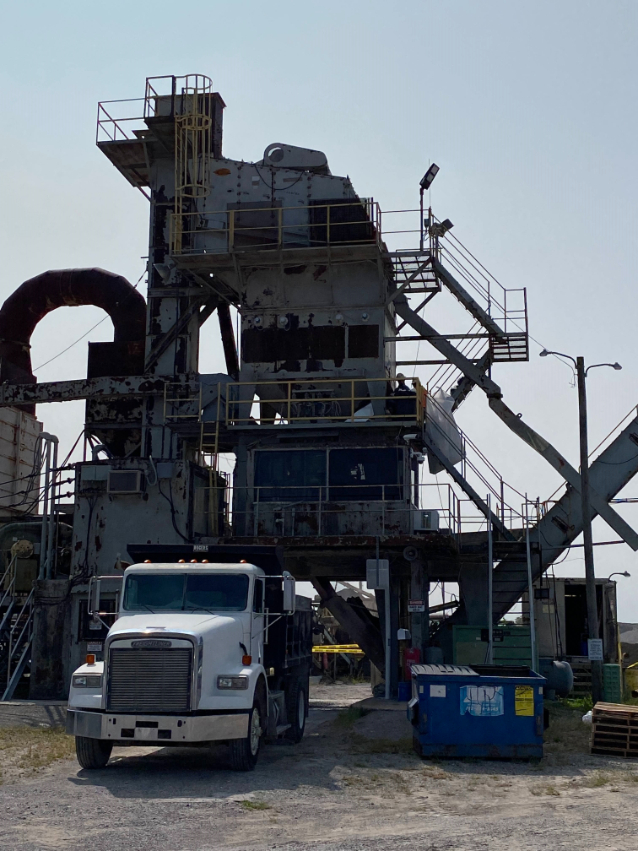
New rubberized asphalt technologies have moved from modified binders to modified mixes. One emerging technology supplied by Liberty Tire Recycling, Pittsburgh, Pennsylvania, called SmartMIX, is a next-generation dry process. It’s a hybrid rubber technology and material that is processed and reacted like an older binder technology’s “wet process,” but handles like a dry powder at the hot-mix asphalt (HMA) plant.
SmartMIX was used in a recent road improvement project in Henderson County, Kentucky. County Engineer Bill Hubiak said he was looking for a way to modify a binder course mix to make it more durable and longer-lasting.
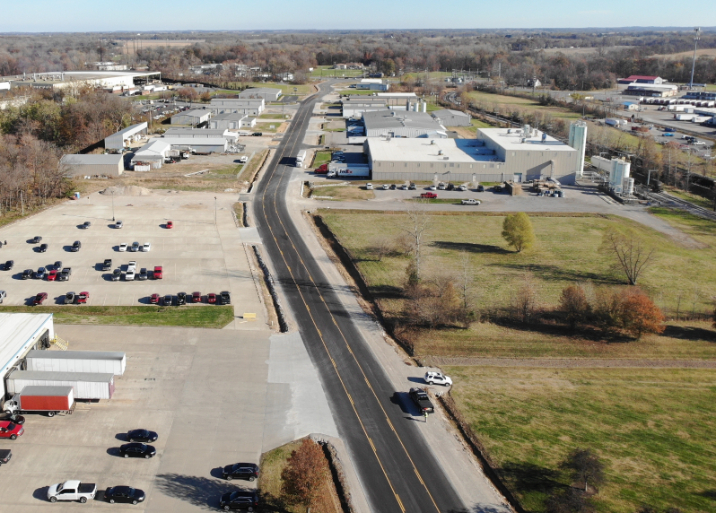
Henderson County Engineer Bill Hubiak anticipates the Superpave mix with SmartMIX technology on Ohio Drive may last an additional three to five years. Photo courtesy of Henderson County
“I’ve been looking for an easier way to use rubberized asphalt,” Hubiak said. “This project on Ohio Drive handles a lot of semi-truck traffic for an industrial zone and we needed a way to beef up the surface. Instead of using the traditional small aggregate, thin surface mix, I decided to use the same mix from the structural layer, which has a little larger rock, a half-inch aggregate instead of a 3/8-inch stone. We also placed it in a 2-inch lift, instead of the traditional 1.5-inch lift for a surface. I needed something that would be tougher to stand up to the load.”
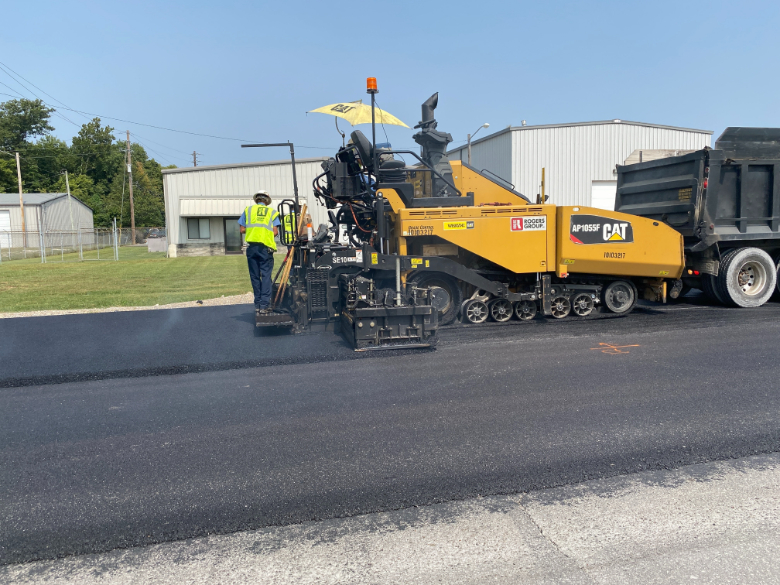
Henderson County Engineer Bill Hubiak explained they placed the surface at 2 inches thick instead of the traditional 1.5 inches. Photo courtesy of Liberty Tire
Cost was a factor as well as strength.
“I didn’t have the budget to add a tank of modified binder at the contractor’s mix plant,” Hubiak explained. “With SmartMIX, we can add it directly to the mix at the contractor’s plant.”
The challenge came in the mechanics of the plant available. The contractor, Rogers Group Inc., headquartered in Nashville, Tennessee, had a 2.5-ton batch plant near the Ohio Drive project. But the batch plant has an aggregate screening system on top where the rubber would get screened out with the fines if the SmartMIX was added with the recycled asphalt pavement (RAP) on the RAP belt.
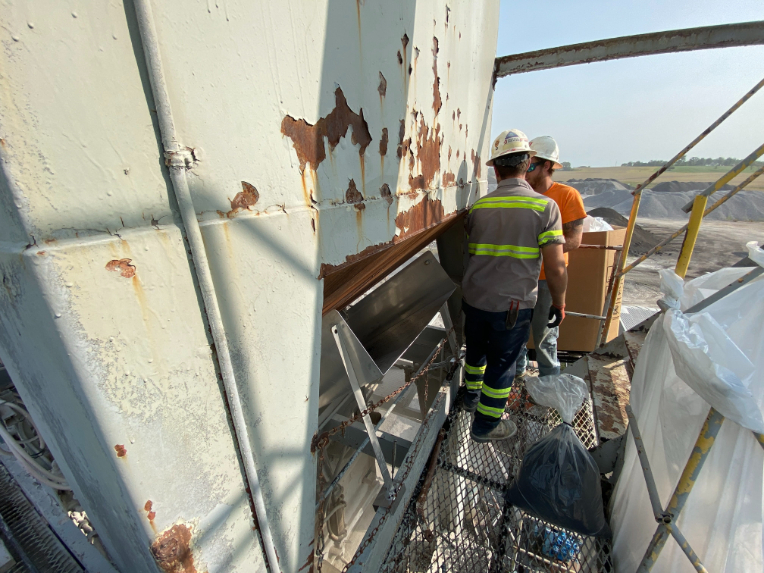
Tim Mann and Mark Farmer of Rogers Group physically cut the bags and poured the SmartMIX down the chute designed for this plant’s unique situation. “Standing on the deck where we were feeding the SmartMIX was like being on an old WW2 Destroyer the way that old plant sounded and moved,” Doug Carlson reported. “It was a powerful rumble. It was simply built and well maintained to do a job and it does that well.” Since this project, Liberty Tire has devised a simple hopper and auger system that can load a batch plant mechanically. Photos courtesy of Liberty Tire
In continuous mixing plants, Liberty Tire normally uses a fiber blower system that has been fitted to handle the rubber powder; it is typically dosed at about 12 pounds of rubber per ton or about 0.6 percent by weight of mix. This dosage rate is based upon extensive testing performed at the National Center for Asphalt Technology (NCAT) where 12 different sizes and sources of rubber were used with the objective of bumping a PG67-22 binder to a PG76-22 modified. It typically takes between 8 and 12 percent rubber, by weight of the binder, to accomplish this. With the SmartMIX, designers basically use the rubber at the 12 percent range.
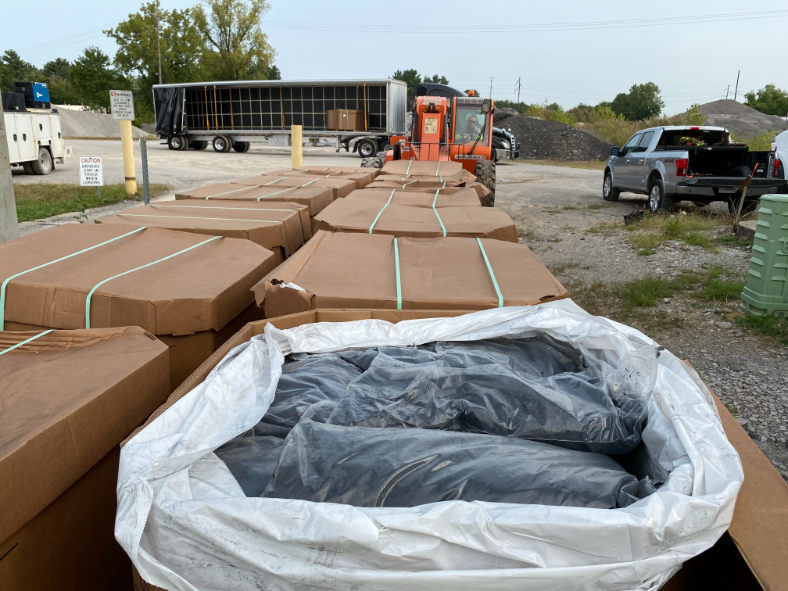
Liberty Tire re-packaged the 2,000-pound bulk bag into the 30-pound bags for workers to lift and add to the batches. The bags were pre-weighed to precisely dose the rubber into the batch. Because the 30-pound bags are kind of delicate, they were packaged in sturdy boxes. Each box was about 1,300 pounds. About 22,800 pounds of the rubber went into the Ohio Drive job. That means the guys handled about 760 bags. Photo courtesy of Liberty Tire
The logistics of handling rubber-modified binder often require special tanks, trucks and equipment. To get around that, Liberty Tire developed a way to add the SmartMIX at the mix plant—like a dry process—while getting a wet-process-like performance. To keep the rubber from swelling and sucking out the light fractions from the binder, SmartMIX is pre-swelled with asphalt extender oil at the Liberty Tire plant through a reacted rubber particle technology (R2PT). With the SmartMIX ready to add, the team needed an opening in the plant for the rubber to go in.
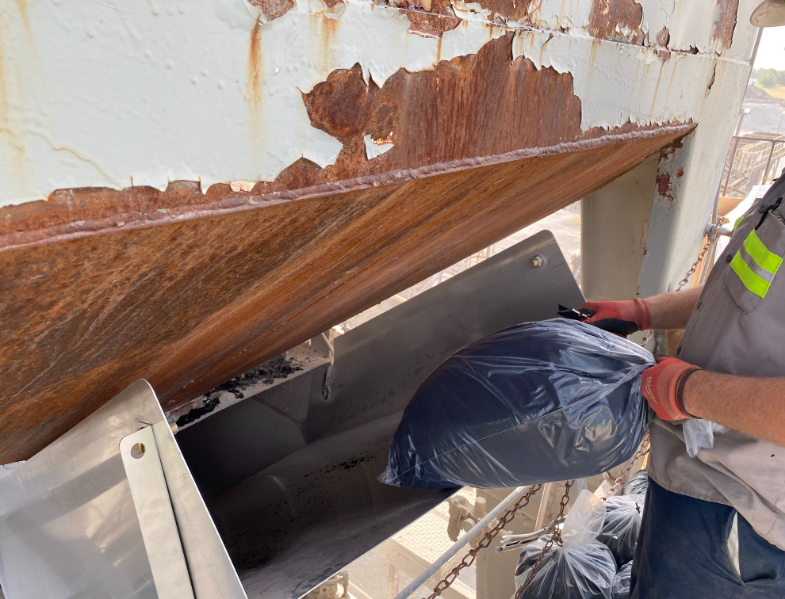
Tim Mann and Mark Farmer of Rogers Group physically cut the bags and poured the SmartMIX down the chute designed for this plant’s unique situation. “Standing on the deck where we were feeding the SmartMIX was like being on an old WW2 Destroyer the way that old plant sounded and moved,” Doug Carlson reported. “It was a powerful rumble. It was simply built and well maintained to do a job and it does that well.” Since this project, Liberty Tire has devised a simple hopper and auger system that can load a batch plant mechanically. Photos courtesy of Liberty Tire
“It’s an old H&B batch plant built in 1957,” James Reece explained. He’s the area manager of asphalt plants with the Rogers Group. “It sorts the fines up top, including the RAP fines, so we couldn’t add the rubber up there. Instead, we decided to pull off a panel that is between the aggregate hopper and the pugmill below. We had a slide chute built that made it easy to drop the rubber in.”
To make the additive easier to handle, Liberty Tire got innovative, as well, repackaging the SmartMIX from its usual one-ton bulk bags into pre-weighed 30-pound bags. The Hi-Tech Asphalt Solutions blowers typically work for continuous mixers, but would not be adequate for the batch application. The team couldn’t cycle the blower and scales on and off quickly enough to keep up with a batch plant. Instead, the crew lifted and dumped the pre-weighed material down the chute.
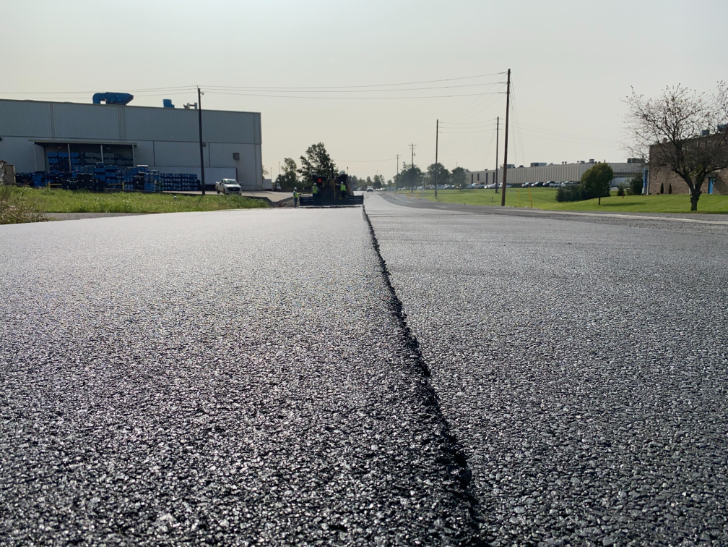
John Hatchett, the Henderson plant operator for Rogers Group, shared: “The batch plant has been in use since the 1950s. Rogers Group acquired it at its current location in the 1970s. The plant has had a couple of upgrades, like an 80-ton silo and scales away from the plant, an indoor control room and computer systems; it all used to be run by hand. And we moved from burning waste oil to natural gas.”
“John has been working with the plant for about 30 years,” Reece bragged. “He knows the ins and outs of the plant like nobody else. He can tell by a sound if something is wrong, probably before the computer can. It [the 2.5-ton batch plant] may be small in terms of production, but it’s reliable. It has the least hiccups, even less than the newer drum plants.
“Our craziest days were during the construction of the I-69 Autobahn Parkway project about seven years ago,” Hatchett recalled. “We ran two shifts, seven days a week, for several weeks to batch out 160,000 tons of mix. That’s a lot of batches! It wore the people out, but not this old plant. It kept chugging along. I think there’s only one more plant like this that’s still assembled, over in Murray, Kentucky.”
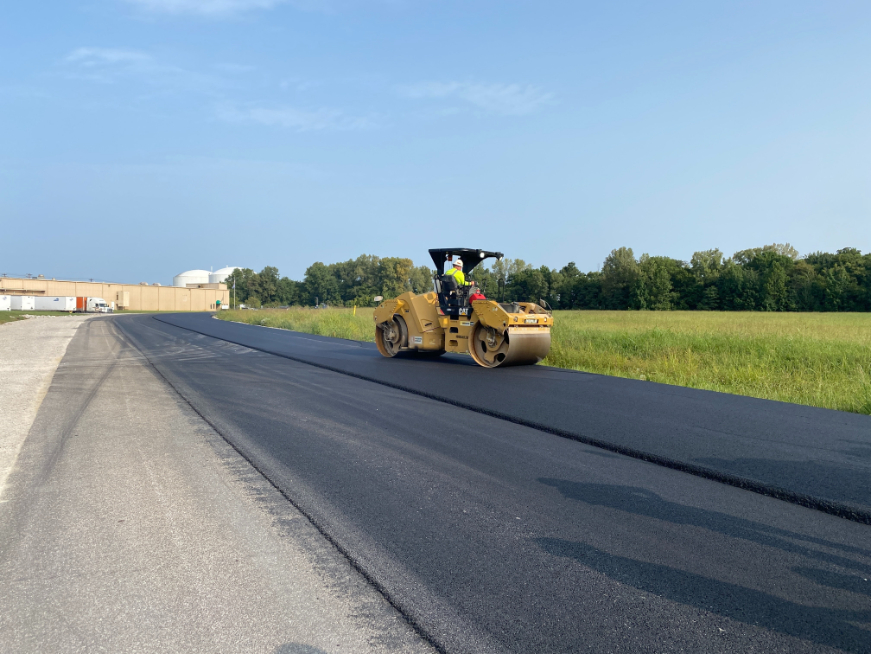
For this Ohio Drive project, Superpave, RAP and rubber remixed the design.
“We added the SmartMIX to our existing Class 3 Superpave mix with a PG64-22 binder,” Jason Vreeland said. He’s the quality control (QC) manager for Rogers Group. “It had 10 percent RAP. We didn’t need to change the mix design or resubmit. You could say we recycled the mix design.
“The Kentucky Transportation Cabinet has asked contractors to collect balanced mix design (BMD) information such as CT-Index and Hamburg on all projects to see where our mixes would be if the BMD were implemented today. Back at our lab, we tested this mix and got good results.
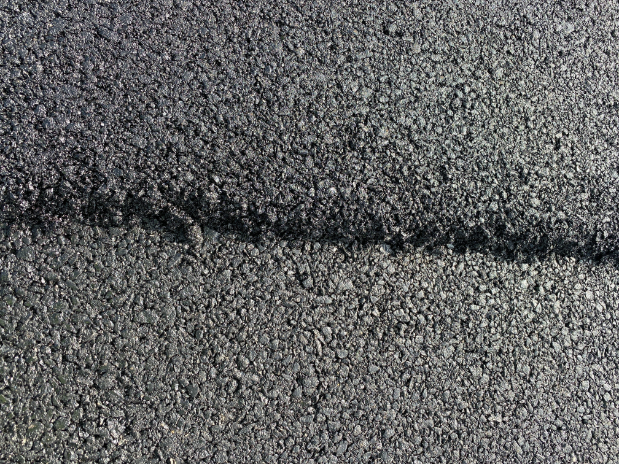
Rogers Group added the SmartMIX to an existing Class 3 Superpave mix with a PG64-22 binder and 10 percent RAP. “I decided to use the same mix from the structural layer, which has a little larger rock,” Bill Hubiak said. Photo courtesy of Liberty Tire
“Rubber is usually good to use to stop reflective cracking,” Vreeland continued. “The mix with the SmartMIX in it had CT-Index numbers above 300 where regular mixes usually have a CT-Index around 200. It makes sense, adding a more flexible component to the mix should reduce cracking and give the higher CT number. Everything else looks good.”
“We were very pleased how the project turned out,” Hubiak said. “We were able to build a part of the project without any rubber so that we could have a good comparison of performance over the years. As a result of the upgrade to this road, one company invested $8 million into its plant on Ohio Drive and added 39 new jobs. That’s a big win for city and county.”
The project also reduced waste—a big win for everyone.
“We usually collect and send off six to ten semi loads of scrap tires each year,” Nancy Watkins said. She’s the coordinator for Henderson County Solid Waste and Recycling. “This project used the equivalent amount of rubber that we would have in one of those loads. Recycled tire rubber can be used in lots of things like track, athletic fields and playgrounds, but using it in a road is a great way to re-purpose the rubber. Rubberized asphalt builds an asset that the whole community can use and can save money. It can build more public support for a paving program.”
“Like many counties around the country, our budgets have been cut and we are a little behind on our upkeep with regard to PCI [pavement condition index],” Hubiak said. “We are always looking for ways we can catch up. If the SmartMIX holds up an extra three to five years compared to the regular asphalt, this could be a cost-effective way to help us provide the public with higher quality roads and streets.”
Doug Carlson is the vice president of asphalt products for Liberty Tire Recycling, Pittsburgh, Pennsylvania. For more information, contact Carlson at (412) 562-1700 or visit www.libertytire.com.
